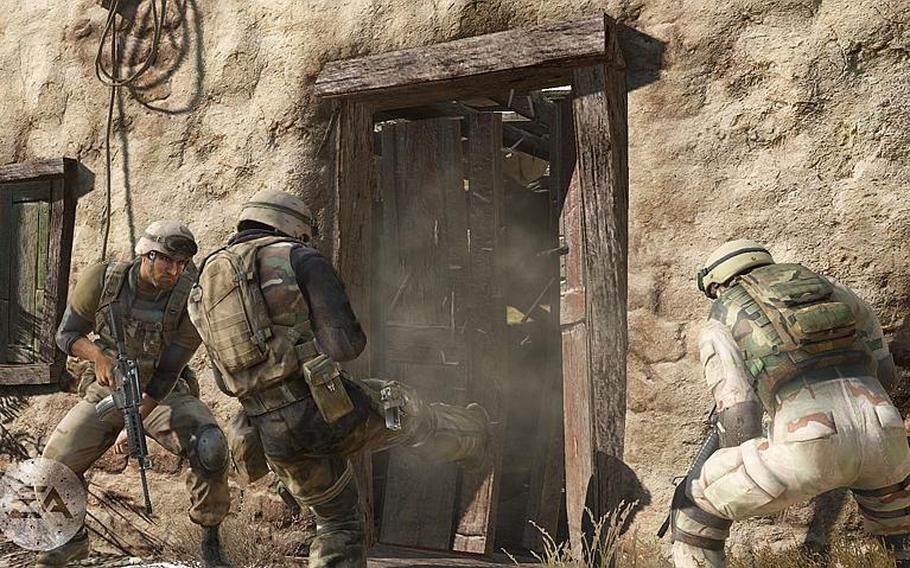
Rangers kick in a door in 'Medal of Honor.' (Electronic Arts)
Developers aimed for realism when they created “Medal of Honor,” a new shooter that re-creates the early days of the war in Afghanistan.
One of their nods to realism — using the name “Taliban” to designate one of the factions in the multiplayer mode — ended up drawing widespread criticism and a ban by the Army and Air Force Exchange Service. However, the rest of the team’s efforts end up making “Medal of Honor” a good game.
The M-rated game, which was developed by Danger Close and Dice for Electronic Arts, focuses on the actions of special operations forces. In the game’s campaign mode, you play as “Tier 1 operators” and Army Rangers, as well as spend some time aboard a helicopter gunship.
While working on these missions, Danger Close drew on the experiences and guidance of real special ops troops. The effort shows. The game’s story line, mission structure, activities and dialogue are much more realistic than those in the franchise’s biggest competitor: “Call of Duty: Modern Warfare 2.” No intrigue involving Russian ultra-nationalists. No invasion of the United States. And no gunning down American troops — at least in the campaign.
Most of the missions involve assaults on remote villages and camps. Things might start off stealthy, but it’s rarely long before the area erupts in a cacophony of gunfire and grenade blasts. Some of the action can get downright frantic as you and your team face waves of enemy fighters.
Despite that, “Medal of Honor” often lacks the intensity of many other combat games. Bumping the difficulty up to the highest setting helps, but few of the missions pack the tension and emotional payoff found in some other titles. It seems that developers decided that hordes of enemies are a substitute for compelling level design.
Technically, the game is very good. The controls are smooth and efficient. The graphics do a good job of portraying the stark landscapes and desolate villages of Afghanistan. The character rendering and animations are solid.
The controversy surrounding the game revolves around its multiplayer mode, which was developed by Dice. In its original form, the multiplayer mode featured one team playing as American servicemembers and the other playing as Taliban. This drew fire from veterans, survivors of fallen troops and government officials, who said it was distasteful
SEE MEDAL ON PAGE XX
to allow gamers to play as members of a group that’s currently fighting and killing U.S. troops. In response, Electronic Arts changed the name of the second side to OPFOR — or opposing force. This move brought the game in line with “Modern Warfare” and “Battlefield: Bad Company” — another Dice creation — both of which feature generic Middle Eastern fighters opposing U.S. troops in their multiplayer modes.
Despite dropping the name “Taliban,” the mode does offer a few things that might seem uncomfortably close to reality. Some of the maps — “Helmand Valley,” “Mazar-I-Sharif Airfield” and “Kandahar Marketplace,” for example — are very familiar. And the turbaned OPFOR fighters have the ability to pull out a cell phone to detonate explosives, IED-style. It hits a little closer to home than most other combat games.
From a gameplay standpoint, the multiplayer mode is very good. It focuses on goal-oriented team competition, which will be familiar to fans of the “Battlefield” franchise. In “Combat Mission,” coalition forces try to take a series of objectives from the opposing force. In “Objective Raid,” coalition forces must defend against attempts by opposing forces to overrun their strongpoint. “Sector Control” lets the teams fight over three objectives, with points going to the side that maintains control. And “Team Assault“ is basically a standard death match.
You can choose from three classes of soldier: rifleman, special ops and sniper. You advance in each class independently, unlocking improvements to your weapons as you go. The classes and weapons are very well balanced, which keeps competition even. The maps and the missions are well designed, offering an excellent mix of close-quarters and mid-range combat. Unlike other games developed by Dice, there are relatively few opportunities to use vehicles or obliterate your enemy’s cover with artillery fire — though some cover is somewhat destructible.
In addition to the campaign and multiplayer modes, “Medal of Honor” offers the “Tier 1” mode in which you can replay missions to see how quickly you can complete them or how many “skill kills” you can achieve — with your resulting scores being posted online.
However, that’s it. Most other shooters offer co-operative play or other challenges, such as a survival mode. The absence of these options seriously limits the game’s “fun quotient.” With the superb “Halo: Reach” already out and highly anticipated “Call of Duty: Black Ops” waiting in the wings — both of which offer such options — it seems like “Medal of Honor” is short a few rounds of ammo.
The game gets high marks because of its realism and general game play — especially in the multiplayer mode. However, a certain lack of intensity in the campaign and the absence of options that are available in other games hold it back a bit.
Platforms: Xbox 360, PlayStation 3 (tested)
Online: www.medalofhonor.com